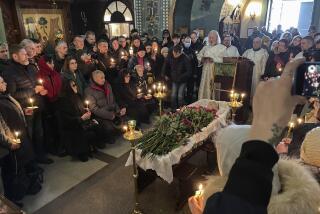Romanov rumors are put to rest
- Share via
The most enduring and romantic legend of the Russian Revolution -- that two children of Czar Nicholas II and his wife, Alexandra, survived the slaughter that killed the rest of their family -- may finally be put to rest with the positive identification of bone fragments from a lonely Russian grave.
The czar and his family were gunned down and stabbed by members of the Red Guard early on the morning of July 17, 1918, but rumors have persisted that two of the children, the Grand Duchess Anastasia and her brother Alexei, survived, perhaps because the diamonds sewn into their clothes blocked attempts to kill them.
Those hopes were bolstered with the 1991 revelation that nine bodies of Romanov family members and servants had been found in a Yekaterinberg grave, but that a son and daughter were still missing.
Now, newly analyzed DNA evidence from a second, nearby grave discovered in 2007 proves that the bones are those of two Romanov children, ending the mystery once and for all. A report on the analysis was published online Tuesday in the journal PloS One.
“I think it is very compelling evidence that this family has been reunited finally,” said geneticist Terry Melton of Mitotyping Technologies in State College, Pa., an expert in forensic DNA. Melton, who was not involved in the new research, played a major role in disproving the famous claim of the late Anna Anderson that she was Anastasia.
Melton says she still receives several calls each year from people claiming to be direct descendants of the Romanovs.
“There is absolutely no doubt that these are the remains of the Romanov family,” said Peter Sarandinaki, founder of the Scientific Expedition to Account for the Romanov Children, which has been seeking the remains of the family.
“The scientific results are, without a doubt, conclusive,” said Sarandinaki, the great-grandson of the White Army general who attempted to rescue the Romanovs before their deaths.
Nicholas II abdicated the throne in March 1917, ending the 304-year Romanov rule, and the family was banished to Siberia.
The following year, the family, their doctor and three servants were executed by the Red Guard on the orders of Vladimir Lenin and their bodies disposed of.
Russian film director Gely Ryabov, an amateur archaeologist, found the remains of nine bodies in an unmarked grave near Yekaterinberg in the early 1970s, but kept the discovery secret until 1991, after the fall of the Soviet Union.
DNA testing in the 1990s by geneticist Peter Gill of the University of Strathclyde in Glasgow, Scotland, indicated that the remains were those of the czar and czarina and three of their daughters. For comparison samples, researchers used DNA from Britain’s Prince Philip, whose grandmother and the czarina’s grandmother were sisters, and from indirect descendants of the royal family.
Two years ago, archaeologists found a second grave about 70 yards from the first. It contained 44 broken and burned bone fragments, consistent with reports that the Red Guard unsuccessfully tried to burn the remains of two of the dead children before burying them.
Russian authorities enlisted the help of geneticist Michael Coble of the Armed Forces DNA Identification Laboratory in Rockville, Md., the world’s largest mitochondrial DNA testing facility, specializing in identifying the remains of U.S. soldiers.
Coble is lead author of a report on the findings.
Preliminary analysis suggested that the fragments were from two people, a female age 17 to 24 -- some speculate it is daughter Marie -- and a male age 14 to 16.
Coble and geneticist Anthony Falsetti of the University of Florida extracted DNA and compared it with DNA from the bones found earlier and to DNA from a leg bone of Nicholas’ brother Georgij, who died of tuberculosis as a young man.
Using new technology that allows use of extremely small samples, they were also able to match the DNA from all the Romanov family members to DNA from a bloodstained shirt that had been worn by Nicholas on April 29, 1891, when he was attacked by a Japanese policeman while touring the city of Otsu. The bloody shirt had been preserved in Russia.
The matches were all perfect. “The genetic evidence is really overwhelming,” Coble said.
Their results were then independently replicated by geneticist Walther Parson of the Institute of Legal Medicine in Innsbruck, Austria, and confirmed by Gill.
“This closes the book on this particular chapter of the Romanov history,” said forensic anthropologist Susan Myster of Hamline University in St. Paul, Minn.
“There are still people who are going to want to believe that there were survivors, and God bless them, but I am confident that the royal family has been found, they have been identified and there was no escape, no princess,” Falsetti said.
But the story is not quite over. The original nine bodies were buried in Russia, but not as royalty, Sarandinaki said.
In May, he and Coble will present the new results to officials of the Russian Orthodox Church.
“Hopefully, we will be able to convince the church [that these are the remains of the royal family], and at the end, the church will agree and finally give the family the decent and honorable burial they deserve,” Sarandinaki said.
“Once the church accepts the remains, my duty will be done,” he said.
--
More to Read
Sign up for Essential California
The most important California stories and recommendations in your inbox every morning.
You may occasionally receive promotional content from the Los Angeles Times.










